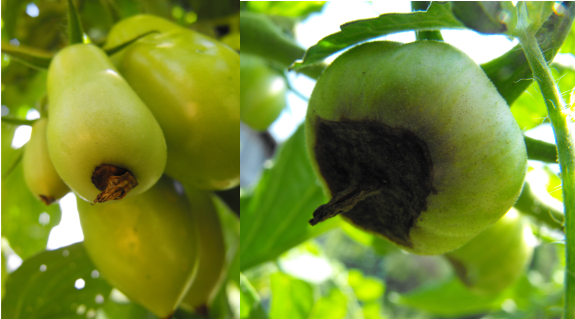
Blossom end rot

If some of your tomatoes
have a black spot on the bottom, chances are
they've come down with blossom end rot. This condition isn't
something to be overly concerned about since it's not caused by a
virus, bacterium, or fungus and won't travel beyond the fruit in
question.
Technically, blossom end
rot is caused by lack of calcium, but that
doesn't necessarily mean your soil is low on the essential
micronutrient. A variety of other
factors can reduce your plants'
ability to take up calcium, including drought, damage to the plant's
root system, excessive heat, or even rapid plant growth.
I'm not as careful as I
could be about making sure my tomatoes always
have an even supply of water, so I often find a fruit here and there
that has succumbed to blossom end rot. The affected plants are
most common at the beginning of the season, and are more prevalent in
certain varieties than in others. If blossom end rot seemed to be
excessively widespread in your garden, you should mulch your tomatoes
to maintain an even supply of
water in the soil and should take care not to overfertilize.
Otherwise, just cut out the spot and enjoy your homegrown tomatoes.
| This post is part of our Minor Tomato Ailments lunchtime series.
Read all of the entries: |
Want more in-depth information? Browse through our books.
Or explore more posts by date or by subject.
About us: Anna Hess and Mark Hamilton spent over a decade living self-sufficiently in the mountains of Virginia before moving north to start over from scratch in the foothills of Ohio. They've experimented with permaculture, no-till gardening, trailersteading, home-based microbusinesses and much more, writing about their adventures in both blogs and books.
Want to be notified when new comments are posted on this page? Click on the RSS button after you add a comment to subscribe to the comment feed, or simply check the box beside "email replies to me" while writing your comment.
- Remove comment
- Remove comment
